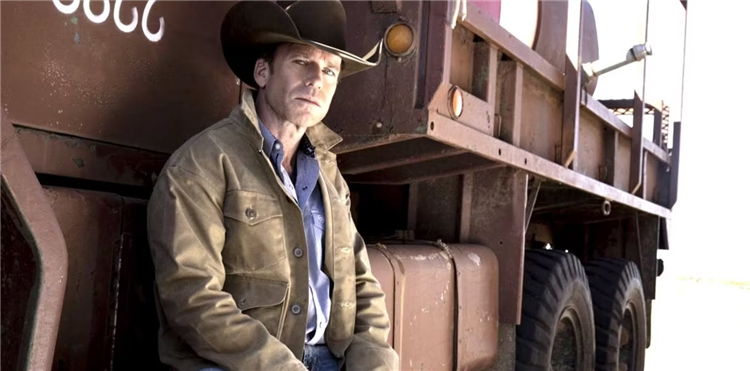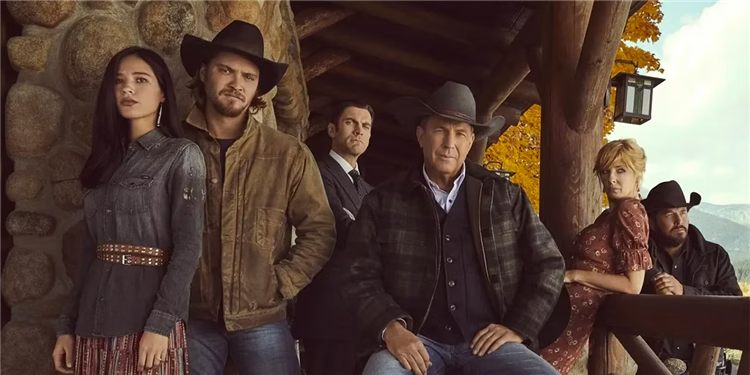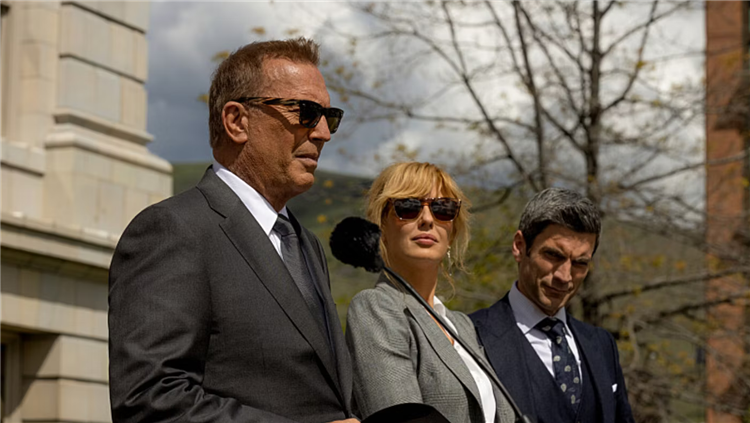Maybe Sheridan needs to get back in touch with his Texan roots.
- Taylor Sheridan’s success with Yellowstone has made him one of the biggest creators in Hollywood, expanding his television universe and audience with each season and spinoff.
- Sheridan’s work emphasizes blue-collar projects and sheds light on lesser-known truths of the American West, contributing to the resurgence of Western-related media.
- While Yellowstone has been a hit, there are concerns that Sheridan may be over-extending himself and focusing too much on spinoffs and other projects, leading to a lack of originality and quality in the series.
As Yellowstone gears up for the back half of its fifth and final season, it seems like the end of an era for Taylor Sheridan and his ever-expanding television universe. First premiering in 2018, the Kevin Costner-led series has grown into a national phenomenon, expanding its audience with each season, and with each new spinoff. Whether you’re a fan of the neo-Western or not, Sheridan’s quick rise as one of the biggest creators in Hollywood is nothing short of impressive, as is the show’s vast footprint. But with so many Sheridan projects flooding the Paramount machine, it’s easy to wonder: did the filmmaker peak creatively with Yellowstone?

Admittedly, the Yellowstone phenomenon is nowhere near over. Aside from Sheridan’s own host of spinoffs and sister series, shows like Big Sky, Walker, Joe Pickett, and Outer Range owe part of their existence to Yellowstone‘s success (though it’s worth noting that Longmire and Justified walked so that Sheridan could run). There’s no doubt that the show’s popularity has led to a resurgence in Western-related media, be it on television or the big screen; nevertheless, some of Sheridan’s harshest critics have wondered if the filmmaker may be overly extending himself and grasping beyond his means.
Taylor Sheridan Has Become a Paramount Icon

Before Taylor Sheridan became a sought-after commodity, he was an actor who appeared on shows like Veronica Mars and Sons of Anarchy. While fighting to make a name for himself as an actor, Sheridan fell in love with screenwriting, and as it turned out, he’d make more of an impact on Hollywood from behind the camera instead of in front of it. By 2015, he had penned the screenplay for the Denis Villeneuve film Sicario, which jump-started his career as a screenwriter, and after a few years (and a few more films) he took on the director’s chair. In 2018, he launched Yellowstone for the Paramount Network, thus beginning his tenure as a creator and showrunner.
Since then, Sheridan has created seven original television programs for the Paramount Network and its streaming service Paramount+ (including the reality TV series The Last Cowboy), with four more confirmed projects coming down the pipeline. There’s no denying that the cowboy-turned-filmmaker has been busy, and what’s more, he shows no signs of slowing down. Aside from the greater Yellowstone Universe, Sheridan’s also worked with Jeremy Renner on Mayor of Kingstown, Sylvester Stallone on Tulsa King, and now Zoe Saldaña on Special Ops: Lioness, which just made its debut on Paramount+. Even if the quality between these shows varies, it’s unlikely that Paramount will drop their golden boy any time soon.
Taylor Sheridan’s Work Has Emphasized Stories Often Ignored By Hollywood

In many ways, Sheridan has proven that blue-collar projects, including those with a potentially conservative bent, have a massive audience. While critics may not always embrace those tales, American audiences generally do. Additionally, the same can be said about the Western itself. While Westerns have been around for a long time, there’s no denying the resurgence of the genre following the success of Yellowstone (though Red Dead Redemption II might’ve helped too). After years of putting Westerns on the back burner, Hollywood seems interested again, and Sheridan’s work is a large part of that.
Additionally, the filmmaker often sheds light on issues and places not usually developed in your standard Hollywood movie. Whether it’s the poverty and style of West Texas depicted in Hell or High Water, the harshness of reservation life as seen in Wind River, or the treacherous wildfires that plague the Pacific Northwest as explored in Those Who Wish Me Dead, Sheridan takes his time to highlight the lesser-known truths of the American West. This, of course, is also why Yellowstone became so immensely popular. Between the beauty of Paradise Valley, Montana, and the all-too-real conflicts between out-of-staters and locals trying to survive, the series does a decent job of representing the real-life location. Well, most of the time.
‘Yellowstone’ Has Expanded Beyond Expectation

It’s no secret that most critics were mixed on Yellowstone when it first premiered. The neo-Western didn’t exactly fit the usual “must-watch TV” model, and the show’s juxtaposition between soapiness and violence at times gets the best of it. But the truth is, when the series premiered, there wasn’t anything like it on television. Sure, neo-Westerns had been prancing around for a while (the aforementioned Longmire ran for six seasons, having ended the year prior), but Yellowstone stood out from the get-go due to longtime Western legend Kevin Costner and the cinematic quality brought to the modern, yet still mythical, American West.
And then it exploded. By the time Yellowstone arrived on Peacock in 2020, the series’ audience had more than doubled. Beating out The Walking Dead as the most-watched show on cable, Sheridan’s neo-Western has been a hit on both traditional television and streaming mediums. Even now, the Yellowstone brand continues to extend beyond the fences Sheridan originally put in place, with prequels like 1883 and 1923 becoming just as notable and acclaimed as the flagship series. No wonder there are three more spin-offs/prequels currently in development. But that actually may be a part of the problem.
It Feels Like Taylor Sheridan Has Moved On From ‘Yellowstone’

Early on, the show centered its plot largely around John Dutton’s (Costner) desire to save his family land, the mystery behind the Dutton Ranch’s hierarchy, and Kayce’s (Luke Grimes) struggle between family and responsibility. These ideas — among others such as the Beth (Kelly Riley) and Rip (Cole Houser) romance — promised drama and suspense, with clear antagonists like Chief Rainwater (Gil Birmingham) and Dan Jenkins (Danny Huston) set up as stand-ins for displaced Native Americans and greedy out-of-state transplants. But what started as a fresh idea rooted in real-world politics, blue-collar conflicts, and Sheridan’s trademark style has become stale over time, revisiting the same old plots and character arcs nearly every season so that you can easily miss an episode or two without consequence.
No doubt, Yellowstone‘s ill-inspired recycling (echoing the greater Hollywood machine itself) is a problem, but the bigger issue is that Sheridan seems to be over-extending. The entire fourth season was a jumbled mess that felt more like a never-ending commercial for the stories he was actually interested in telling, such as the exceptional prequel series 1883 and the still yet-to-be-released 6666 spinoff centering on the historic Four Sixes Ranch in Texas (which Sheridan just so happens to own). Additionally, Mayor of Kingstown — which he co-created with Hugh Dillon — was released the same year, meaning that Sheridan’s attention has been split in more directions than one showrunner could keep straight.
Has Taylor Sheridan Spread Himself Too Thin?

Since 1883 and 1923 fall under the Yellowstone banner, their popularity isn’t unfounded. No doubt, the star power of Sam Elliot, Tim McGraw, Faith Hill, Harrison Ford, and Helen Mirren combined with the unique Western time periods brought in new audiences, but it was clear from the get-go that the faithful Yellowstone audience was largely responsible for their success. The same, however, can’t be said for some of Sheridan’s other non-Western projects. Despite earning two seasons, Mayor of Kingstown was maligned by critics and uncharacteristically (as far as Sheridan-helmed projects are concerned) has yet to be renewed for a third season. In contrast, Tulsa King was favored significantly better and a second season was greenlit before the first finished out in 2022.
But none of these shows have yet to make the cultural dent that Yellowstone has, nor do they have the same type of fan-following. More than likely, they never will. Unlike the Costner-led neo-Western, which told a unique and distinct story in Sheridan’s neo-Western style, there are other shows set in prison towns, and other Italian mobsters on TV. Even Sheridan’s latest television hit Special Ops: Lioness (despite the intense thrills) doesn’t have the same hook that roped audiences in for Yellowstone — though in this case, maybe that’s a good thing as it will give the spy thriller an identity of its own apart from Sheridan’s usual formula. Maybe, as he did with Without Remorse, Sheridan is trying to rebrand himself.
The distinct ideas and themes that Sheridan became known for early on have since been left behind. In many respects, Sheridan seems to be migrating from the American West entirely (much of 1923 doesn’t even take place in Montana), at least as far as the Yellowstone brand will let him. If these shows weren’t enough, the added pressure to deliver various spinoffs (including an anthology series) set within the world of his trademark Western probably doesn’t help. Although Sheridan seems perfectly content to have multiple projects in development at a time (on top of his already full television schedule), one could argue that what initially made his work unique has been lost in the shuffle.
Standalone Stories Are Where Taylor Sheridan Shines Brightest

We live in an era where television is king. The sheer amount of content that is released nowadays is unprecedented, and with so many actors and filmmakers shifting from the big screen to the small, it’s no surprise that Sheridan did the same — and, so far, it’s worked out for him. The success of Yellowstone led to his own television empire, making him the sort of Dick Wolf of prestige television Westerns (with room to grow into other genres, a la Lioness). But, in many ways, Sheridan’s best and most personal stories came from his time writing feature films.
With feature films, the biggest limitation is runtime, and Sheridan has proven himself the master of how to use it effectively. The final ten minutes of Wind River are some of the most powerful put to film, and to this day the filmmaker hasn’t topped those final moments. Additionally, the character arcs in Hell or High Water make for a thrilling and heartfelt story about cops and robbers that Yellowstone has yet to properly imitate. And this isn’t to mention Sicario and its sequel, the first of which is a near-perfect film with a tight screenplay that keeps you tipped on your toes. If Sheridan has proven anything, it’s that he’s an exceptional writer when he knows where he’s headed. When he does, his vision is clear.
Unfortunately, while Yellowstone may mark the height of his popularity, the series proves that long-form television may not be his strong suit. There’s a reason arcs and plotlines are recycled like cardboard, and it’s because the end doesn’t seem to be in view, despite his knowledge of how the story will ultimately end. In contrast, 1883, which Sheridan wrote as if it were a novel, felt like a “ten-hour movie,” with Sheridan using the miniseries’ limitations to his advantage. If that first Yellowstone prequel did anything, it reminded us that standalone stories are where Sheridan truly thrives. Hopefully, one day, he’ll return there.
Yellowstone can be streamed exclusively on Peacock, while all of Taylor Sheridan’s other television projects can be found on Paramount+.
